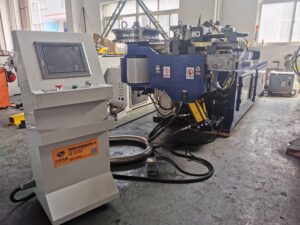The ability to bend tube accurately and efficiently is an invaluable skill. A pipe bender, while seemingly simple, is a powerful tool that unlocks a world of possibilities, allowing you to create custom frames, roll cages, furniture, and so much more.
Forget those frustrating kinks and bends that don’t quite meet your vision! Let’s dive into the world of tube bending and learn how to bend tube like a pro.

Choosing the Right Pipe Bender: Matching the Tool to the Task
The first step to successful tube bending is selecting the right tool. Pipe benders come in various types, each designed for specific applications and materials. Understanding the differences is crucial to avoid frustration and ensure accurate bends.
- Handheld Pipe Benders (Manual Benders): These are the most basic type, ideal for small-scale projects, tight spaces, and bending softer metals like copper and aluminum. They’re relatively inexpensive and portable, but require more manual effort and can be challenging for thicker or harder materials.
- Pros: Affordable, portable, good for tight spaces.
- Cons: Limited bending capacity, requires significant manual effort, less accurate for complex bends.
- Hydraulic Pipe Benders: These benders utilize hydraulic pressure to bend the tube, making them suitable for thicker materials like steel and stainless steel.
- Pros: High bending capacity, precise control, suitable for tougher materials.
- Cons: More expensive than manual benders, less portable.
- Electric Pipe Benders: Combining power and precision, electric pipe benders offer the most efficient and consistent bending experience. They’re often used in professional settings where speed and accuracy are paramount.
- Pros: Fastest bending, extremely precise, high bending capacity.
- Cons: Most expensive type, requires a power source.
- Rotary Draw Benders: These benders are designed for creating smooth, tight-radius bends in tubing. They use a rotating die to draw the tube around a bending form, minimizing distortion and creating professional-looking curves.
- Pros: Excellent for tight radius bends, minimizes tube distortion, professional-quality results.
- Cons: Most complex and expensive type, requires specialized dies.

Key Considerations When Choosing a Pipe Bender:
- Material: Consider the type and thickness of the tubes you’ll be bending. Softer metals require less force, while harder metals necessitate hydraulic or electric benders.
- Tube Diameter: Ensure the bender you choose can accommodate the diameter of your tubes. Most benders come with interchangeable dies for different tube sizes.
- Bend Radius: Determine the minimum bend radius required for your project. Different benders have different limitations on the tightness of the curves they can produce.
- Budget: Pipe benders range in price from affordable handheld models to high-end electric machines. Set a budget and choose a bender that meets your needs without breaking the bank.
- Project Scope: How often will you be bending tubes? If it’s a one-time project, a manual bender might suffice. For frequent use, a hydraulic or electric bender will be a worthwhile investment.



